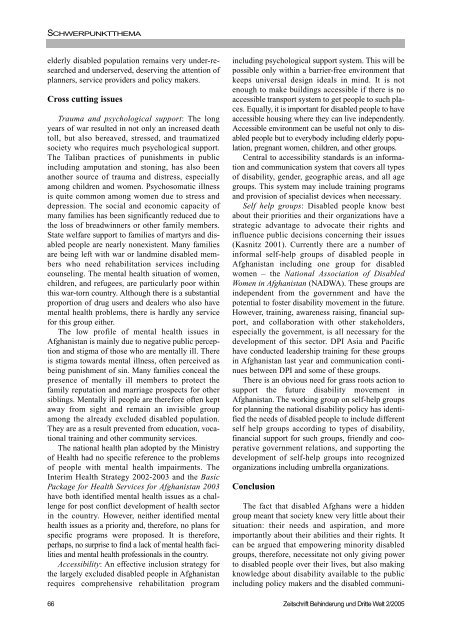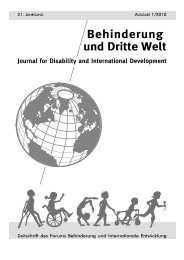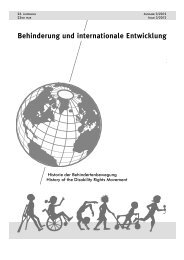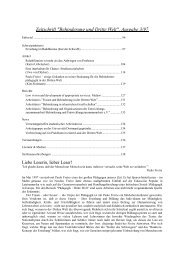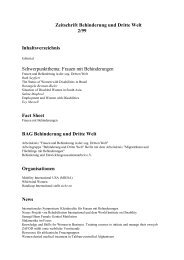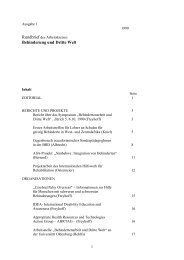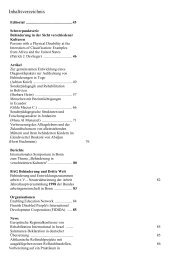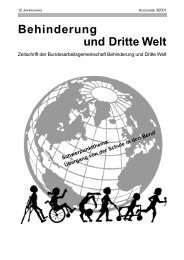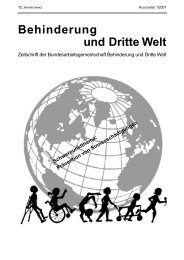Armut und Behinderung - Behinderung und Dritte Welt
Armut und Behinderung - Behinderung und Dritte Welt
Armut und Behinderung - Behinderung und Dritte Welt
Create successful ePaper yourself
Turn your PDF publications into a flip-book with our unique Google optimized e-Paper software.
SCHWERPUNKTTHEMAelderly disabled population remains very <strong>und</strong>er-researchedand <strong>und</strong>erserved, deserving the attention ofplanners, service providers and policy makers.Cross cutting issuesTrauma and psychological support: The longyears of war resulted in not only an increased deathtoll, but also bereaved, stressed, and traumatizedsociety who requires much psychological support.The Taliban practices of punishments in publicincluding amputation and stoning, has also beenanother source of trauma and distress, especiallyamong children and women. Psychosomatic illnessis quite common among women due to stress anddepression. The social and economic capacity ofmany families has been significantly reduced due tothe loss of breadwinners or other family members.State welfare support to families of martyrs and disabledpeople are nearly nonexistent. Many familiesare being left with war or landmine disabled memberswho need rehabilitation services includingcounseling. The mental health situation of women,children, and refugees, are particularly poor withinthis war-torn country. Although there is a substantialproportion of drug users and dealers who also havemental health problems, there is hardly any servicefor this group either.The low profile of mental health issues inAfghanistan is mainly due to negative public perceptionand stigma of those who are mentally ill. Thereis stigma towards mental illness, often perceived asbeing punishment of sin. Many families conceal thepresence of mentally ill members to protect thefamily reputation and marriage prospects for othersiblings. Mentally ill people are therefore often keptaway from sight and remain an invisible groupamong the already excluded disabled population.They are as a result prevented from education, vocationaltraining and other community services.The national health plan adopted by the Ministryof Health had no specific reference to the problemsof people with mental health impairments. TheInterim Health Strategy 2002-2003 and the BasicPackage for Health Services for Afghanistan 2003have both identified mental health issues as a challengefor post conflict development of health sectorin the country. However, neither identified mentalhealth issues as a priority and, therefore, no plans forspecific programs were proposed. It is therefore,perhaps, no surprise to find a lack of mental health facilitiesand mental health professionals in the country.Accessibility: An effective inclusion strategy forthe largely excluded disabled people in Afghanistanrequires comprehensive rehabilitation program66including psychological support system. This will bepossible only within a barrier-free environment thatkeeps universal design ideals in mind. It is notenough to make buildings accessible if there is noaccessible transport system to get people to such places.Equally, it is important for disabled people to haveaccessible housing where they can live independently.Accessible environment can be useful not only to disabledpeople but to everybody including elderly population,pregnant women, children, and other groups.Central to accessibility standards is an informationand communication system that covers all typesof disability, gender, geographic areas, and all agegroups. This system may include training programsand provision of specialist devices when necessary.Self help groups: Disabled people know bestabout their priorities and their organizations have astrategic advantage to advocate their rights andinfluence public decisions concerning their issues(Kasnitz 2001). Currently there are a number ofinformal self-help groups of disabled people inAfghanistan including one group for disabledwomen – the National Association of DisabledWomen in Afghanistan (NADWA). These groups areindependent from the government and have thepotential to foster disability movement in the future.However, training, awareness raising, financial support,and collaboration with other stakeholders,especially the government, is all necessary for thedevelopment of this sector. DPI Asia and Pacifichave conducted leadership training for these groupsin Afghanistan last year and communication continuesbetween DPI and some of these groups.There is an obvious need for grass roots action tosupport the future disability movement inAfghanistan. The working group on self-help groupsfor planning the national disability policy has identifiedthe needs of disabled people to include differentself help groups according to types of disability,financial support for such groups, friendly and cooperativegovernment relations, and supporting thedevelopment of self-help groups into recognizedorganizations including umbrella organizations.ConclusionThe fact that disabled Afghans were a hiddengroup meant that society knew very little about theirsituation: their needs and aspiration, and moreimportantly about their abilities and their rights. Itcan be argued that empowering minority disabledgroups, therefore, necessitate not only giving powerto disabled people over their lives, but also makingknowledge about disability available to the publicincluding policy makers and the disabled communi-Zeitschrift <strong>Behinderung</strong> <strong>und</strong> <strong>Dritte</strong> <strong>Welt</strong> 2/2005


